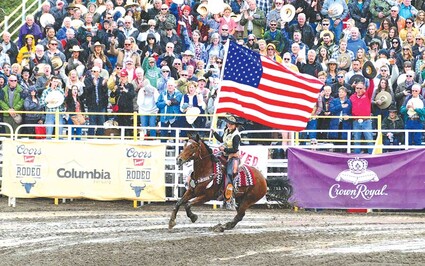Rodeo royalty: queens of hearts
Last updated 6/14/2022 at Noon

BILL BARTLETT
Sisters Rodeo Queen Mary Olney charged into the arena last weekend, to the roar of a sold-out crowd.
Balancing the grit and rough-and-tumble of rodeo are the young women who with grace and style promote the sport. They are the goodwill ambassadors for the deeply rooted American tradition of rodeo. They are rodeo royalty.
Their roles vary to a degree and they can be found selling tickets, appearing at local Western stores, or marketing rodeo at civic association meetings, schools, 4H, FFA, or just mingling — in full regalia — at community holiday gatherings. They sign autographs, serve barbecue, even talk to politicians when needed.
It’s a rich and colorful heritage that would need a book to explain adequately. A book in fact, the definitive history, was written in 2006: “Riding Pretty, Rodeo Royalty in the American West,” by Renee M. Laegried.
Rodeo royalty has its origins in Oregon. When Pendleton held its first large-scale rodeo, it introduced a new kind of rodeo queen—not a traveling cowgirl performer like Annie Oakley but a young, middle-class woman from the hometown. Her name was Bertha Anger.
She won her title from a ticket-selling competition. Anger’s responsibilities were simple: look as regal as possible while riding along the parade route on a float. As rodeo queen then, Anger had little to do with the rodeo, and was not an equestrienne.
In 1910, social norms and expectations for women focused less on her ability to ride a horse (female rodeo competitors were still a novelty at this point) and more on her ability to represent the morals of the community and the town’s Western heritage.
The model for community-sponsored rodeo queens that originated in Pendleton gradually spread to other rodeos throughout the West, giving young women the opportunity to participate both in rodeo and in their communities. From 1910 to 1956, the community-sponsored rodeo queens’ role expanded, both in terms of her responsibilities and in PR for the communities they represented.
While each community adapted the rodeo queen phenomenon to suit the characteristics of its own celebration, the main characteristics of the role remained: the rodeo queen as a symbol of the local rodeo and as a metaphor for Western women.
Sisters Rodeo has a long and storied legacy of rodeo royalty since its inaugural rodeo in 1940. Four were also named Miss Rodeo Oregon and four Miss NPRA (National Professional Rodeo Association). Since 1983 there have been only queens. For many years prior to that there were both queens (18-25) and princesses (13-17).
Applicants for queen apply online in September. Queens are chosen by a panel of judges who interview each candidate with a list of questions. The candidates then present their prepared speeches to a crowd of rodeo guests. After the speeches, they take their horses into the arena to ride a designated pattern that shows the skills and communication between the horse and rider, in a series of figure eights at fast and slow canters. The horse must also stop, stand still, and back with consistency. Finally, a rider demonstrates her handling of her horse running at high speed around the arena, with the classic rodeo wave to the crowd.
The entry of the queen at full gallop carrying a five-foot-wide American flag is one of rodeo’s favorite moments. This year’s rodeo was no exception, as Queen Mary Olney charged into the arena, sparking a crowd eruption.
Few in Sisters Country have more rodeo royalty DNA than Patti Adair, now 70. Her aunt, Judy Currin, was Roundup Queen and Miss Rodeo Oregon the same titles that went to Adair’s sister, Janice.
Adair herself was a princess in the Morrow County rodeo, and princess and queen in the Pendleton Roundup, the latter in 1971, roles also held by her mother, Kathyrn Lazinka Healy Thorne. Two nieces and a cousin have been princesses or queens.
Sara Marcus-Deraldine was Sisters Rodeo Queen in 2012. She became Miss NPRA in 2013 and Miss Rodeo Oregon in 2014. Now married and a 911 dispatcher in Eugene, she will never forget her rodeo life.
“When I went to my first Sisters Rodeo in 1999, I looked at my mom and said I’m going to do that,” she recalled.
She credits the Sisters Rodeo Board for her success.
“They were amazingly supportive, much more I learned when competing than similar boards,” she said.
The royal lifestyle is not inexpensive. Wardrobe expenses alone can run $15,000 a year, she reported. Then there’s travel and horse and tack upkeep. It’s a major commitment in time and money, putting queens on the road as much as 26 weeks a year. Miss Rodeo Oregon contestants must attend a minimum of eight statewide rodeos. Marcus-Deraldine was able to attend 15 with the added help of the Sisters Rodeo Board.
Rodeo royalty is rigorous, with competitive age brackets. In Oregon there’s Miss Rodeo Sweetheart for 4- to 8-year-olds, Junior Miss Rodeo for ages 8 to 13. Miss Teen Rodeo for royalty 13 to 18. To be Miss Rodeo Oregon, contestants must be 21 to 27.

















Reader Comments(0)